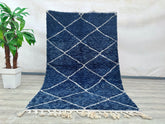Traditional and modern Berber carpets
The Origins of the Berber Carpet
The roots of the Berber carpet trace back to the Paleolithic era, reflecting a cultural heritage woven deeply into Moroccan history. For centuries, these carpets have been crafted using traditional methods and symbolic patterns on looms, preserving the essence of Berber life. Each design, unique in its symbolism, embodies elements of spirituality, beliefs, and the Berber way of life, passed down from mother to daughter. Authentic Berber rugs, handwoven for home use, remain a testament to cultural continuity, even as newer materials and styles emerge.

Berber Carpets as a Symbol of Dowry and Heritage
Historically, young Berber women crafted carpets to include in their dowries. Families often stored these rugs with great care, valuing them as assets that could provide financial support during challenging times. Typically made of wool, two popular types—Beni Ourain and Azilal—stand out. Beni Ourain rugs feature black geometric patterns on a white background with thick wool, while Azilal rugs display more colorful patterns and richer textures. Less-affluent families turned to upcycling old clothing into what are now known as Boucherouite rugs, or "the poor man’s rug ."
Traditional and Modern Berber Rugs in North Africa
Contemporary Berber rugs embrace the classic pile style, closely resembling the traditional knotted patterns of handcrafted Berber rugs. These modern versions blend subtle dark tones against lighter backgrounds, exuding a natural, earthy feel. Unlike traditional rugs, modern Berber carpets often feature a single color or soft patterns and are known for their affordability and durability, making them accessible to many. The vibrant designs in traditionally handwoven Berber rugs set them apart from other oriental styles, offering a lively yet grounded aesthetic.

Handcrafted Berber Carpets as a Source of Income
In rural Berber communities, carpet weaving remains an essential source of income. Families often produce and sell these handcrafted rugs at local markets, providing a livelihood that bridges past traditions with present-day needs. While traditional Berber rugs have a cultural authenticity, mass-produced versions in commercial markets differ in quality and materials, using synthetic fibers to accommodate demand.
The Evolution of Berber Rugs and Materials
Modern Berber rugs now come in various materials, including nylon, olefin, and wool. Tunisian Berber carpets, known as Margoum, uphold ancestral weaving methods, regulated to ensure quality and cultural preservation. The Tunisian government mandates natural wool and forbids synthetic materials, stamping each piece with a distinctive wax seal. This rigorous standard preserves the intricate designs and symbolism of Berber heritage.
Durability and Care for Berber Carpets
Highly durable, Berber carpets are ideal for high-traffic spaces like offices and schools, being naturally stain-resistant and generally more affordable than thicker carpets. However, caring for them requires special attention. Experts recommend dry cleaning or low-humidity methods for Moroccan olefin Berbers to prevent discoloration. Traditional steam cleaning can cause burns or yellowing on olefin, which may be permanent if not immediately treated by a professional cleaner. To maintain their appearance, Berber carpets should ideally be cleaned every 6 to 12 months to prevent long-term damage.
Conclusion
Berber rugs, whether traditional or modern, add both cultural depth and practical elegance to any space. These handwoven pieces not only embody the rich history of Moroccan artistry but also provide versatile decor solutions for modern homes, making them a beautiful and enduring addition to any living space.
Featured Products
169 x 251 cm = 5.5 x 8.2 ft moroccan wool rug, moroccan style rug, bohemian rug, handmade rug, outdoor patio, beniourain Rug, decor rug, Handmade Gift
- $599.00
$1,830.00- $599.00
- (-67%)
- Unit price
- / per
155 x 247 cm = 5.1 x 8.1 ft Diamonds Blue Soft Dots Berber Runner Rug - Handmade Moroccan Wool, Minimalist Design, Vintage Style, Perfect for Weddings & Bohemian Decor
- $599.00
$1,830.00- $599.00
- (-67%)
- Unit price
- / per










